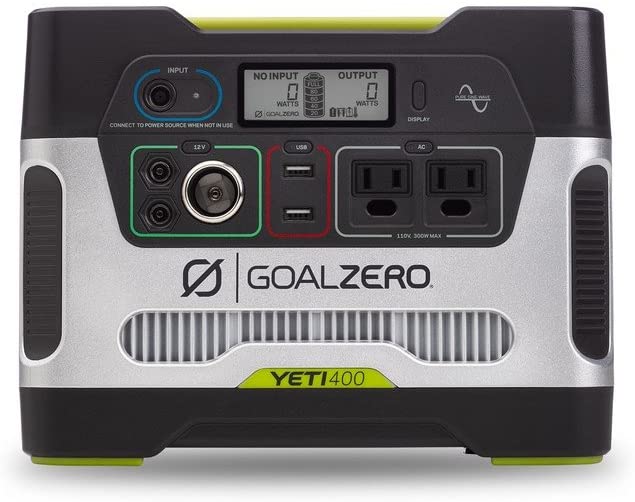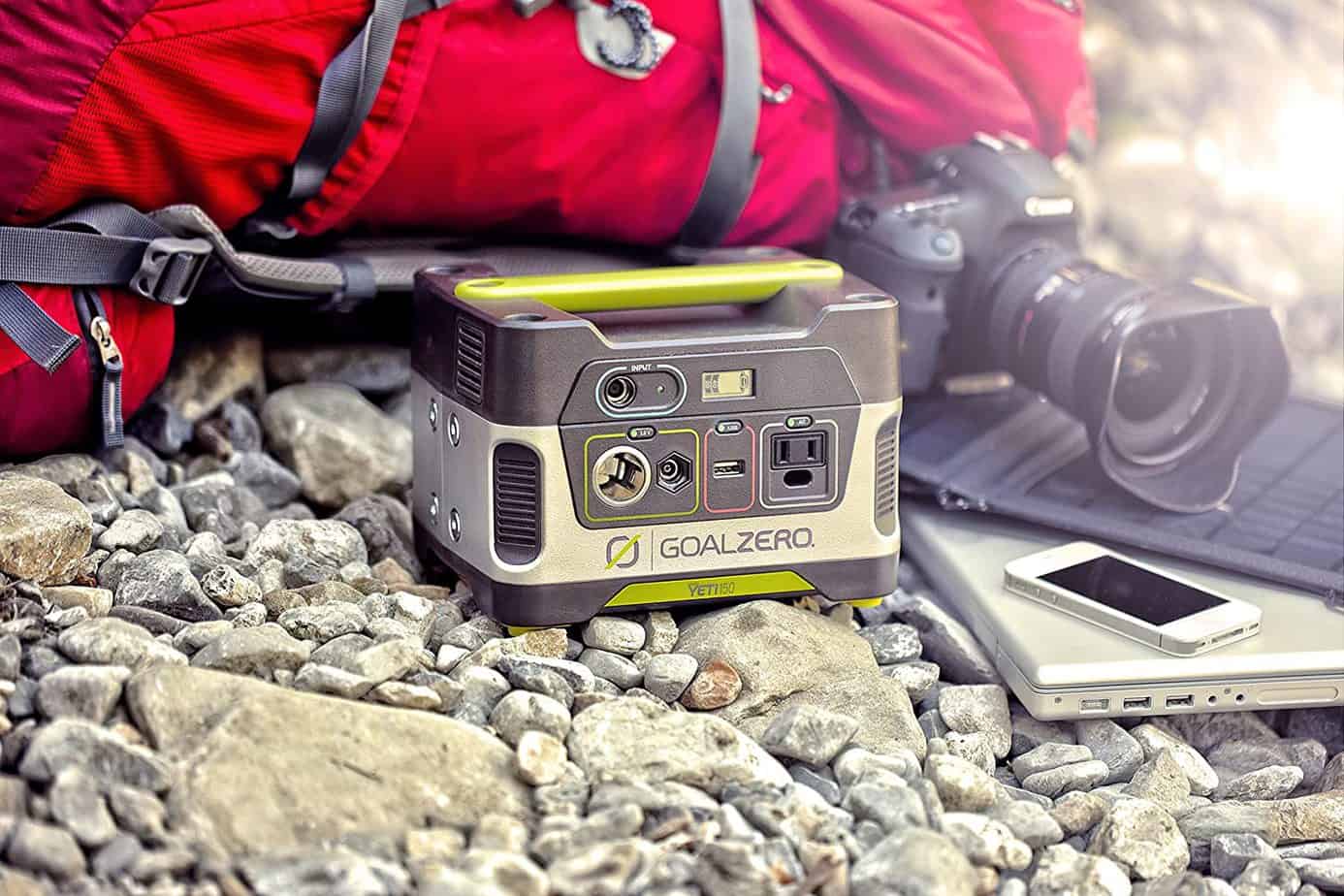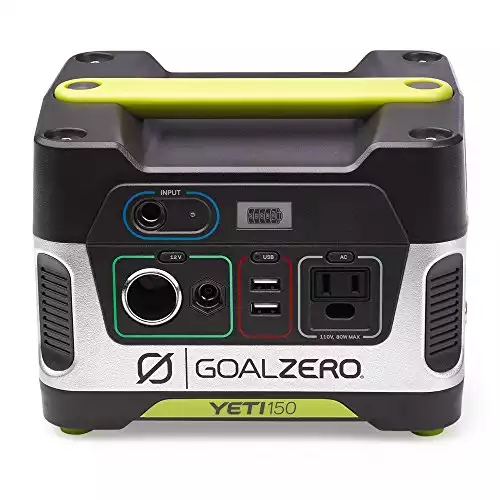Portable power stations have been used for camping, power outages, and various other situations for decades. What started out as gasoline-powered generators has grown to small boxes that you can carry around and plug right into your home outlet for charging. Making portable power more travel friendly and eco-friendly.

With the increase in demand for these portable power stations comes a ton of options. Purchasing a power station is a large investment. You don’t want to pick the first one that pops up on an ad on your computer. Take your time to research different types and figure out what really works for you and your lifestyle.
Table of Contents
What to Consider When Shopping
What type of devices you will be charging and how much you will need to charge them
This will affect the size of the power station you will need. If you are going to be charging laptops or running appliances with your power station, you will want a much more powerful version than if you were only charging your cell phone.
How often you will be able to recharge your portable power station
If you plan to use your portable power station for more long-term trips, it may be wise to get a more powerful battery. You can go longer and plug into a more powerful battery more often without having to recharge your battery. Although, if you plan to use it for short-term trips you will be able to recharge your battery more often and can go with a less powerful option.
How you will be traveling with your power station
You don’t want a 30-pound battery if you plan to use your power station for backpacking. You are going to want one of the lighter versions. The heavier power stations are more powerful. So, if you’re traveling in a vehicle or using it in your home you may want to get one of the cheaper, heavier versions.
How many people will be using your power station
If you’re the only one who will be using your power station, you can afford to get the less powerful options. The more powerful batteries are equipped with more plug-in options, so if more than one person is using your battery, a more powerful version would be a good idea.
What your budget will be for your portable power station and accessories
You will find that these power stations have a ton of helpful accessories, such as solar panels, lights, and even fans. When deciding a budget, you will want to consider all of the accessories you will want to purchase with your power station.

Goal Zero is one of the leading brands in the industry. They caught my attention because of how different they were than most other brands. Below are some of the differences between Goal Zero and other brands.
Charging Versatility
This was the most profound difference I noticed between Goal Zero and other brands. You can charge all of their portable power stations with a DC port in your vehicle, an AC outlet, or one of their many solar panels. They have a different cord for each type of charging that comes with your power station.
This was really important to me because I wanted to use solar energy to recharge. They are one of the only brands that allows you to simply plug any of the Goal Zero solar panels directly into your battery without any electrical wiring needed.
Variety of Powering Options
With most power stations, there are only one or two types of power cord you can plug into it. Goal Zero batteries include 12 Volt ports, AC outlets, and USB ports. You can literally charge anything with this power station.
A Company That Cares
Goal Zero’s original vision was to lift people out of poverty by presenting them with opportunities to build businesses. The founders wanted to create tools for people in poverty needed to build their communities. One way they’ve implemented their vision is by helping with the disaster in Puerto Rico by supplying the island with solar power. For me, this is really important. I love to support companies that give back.
Goal Zero has a huge variety of products. They supply camping lights, fans, speakers, solar kits, and batteries with capabilities ranging from charging your phone to running appliances. Today I will be talking about the Goal Zero Yeti.
Most people use the Yeti for camping, long-term travel, or power outages. The Yeti line is the strongest battery they carry. They range from 150Wh to 3000Wh. You can charge anything from laptops to a 32 inch LCD T.V. with these batteries.
They also make certain Yetis with a lithium battery. The Yetis with lithium batteries start at 400Wh and reach up to 3000Wh. Lithium has a major advantage to the original lead-acid batteries. Lithium is a third of the weight and can hold a charge up to a year whereas the lead-acid battery has to be charged every 3 months.
Lithium batteries are much more expensive. The Yeti 400 lithium battery is $200 more than the original
Personally, I don’t think the price difference is worth the lighter weight and longer-lasting charge. I will be comparing the more affordable lines of the Yetis for you today. The 150Wh lead acid battery and the 400Wh lead-acid battery. See the table below to see the differences between the key features in these power stations.
| Feature | 150 | 400 |
| Powering Options | 1 AC outlet, 2 12 Volt outputs, 2 USB ports | 2 AC outlets, 3 12 Volt outputs, 2 USB ports |
| Dimensions | 7.8 x 6.8 x 5.8 inches | 8 x 10.2 x 8 inches |
| Weight | 12 lbs. | 29 lbs. |
| Price (USD) | $199.95 |
$449.95 |
| Recharge time via Boulder 100 Solar Panel | 3-6 hours | 8-16 hours |
| Recharge via DC port | 4-6 hours | 13 hours |
| Recharge time via wall outlet | 6 hours | 5 hours |
If you’re like me, you have no idea what watt Hours (Wh) translate to. Meaning you don’t really know what the heck you can charge with these things. Well here’s a table showing you what the 150Wh and the 400Wh can power.
| Object Being Charged | 150 Wh | 400 Wh |
| Smartphones | 9-12 charges | 20+ charges |
| Action Cameras | 25 charges | 70+ charges |
| Head lamp | 25-50 charges | 70+ charges |
| Tablet | 6 charges | 10+ charges |
| Laptop | 1-2 charges | 3-5 charges |
| Mini Fridge | N/A | 7 hours |
| 32 inch LCD T.V. | N/A | 3 hours |
Which Yeti you purchase solely depends on your lifestyle and budget. Depending on if you plan to use your power station for long-term travel, short-term trips, or an alternative during power outages will affect your decision. You may also want to consider the different compatible solar panels you can purchase with you battery when making a budget.
Yeti 400 Pros
The Yeti 400 has much more value than the Yeti 150. The 400 costs only a little over double what the 150 costs, yet has almost triple the power. So, if your budget allows, the 400 is a much better deal.
It is also more ideal for long-term travel situations. Your able to power more items without the battery dying nearly as quickly as the 150 would.
You can also power items you would most likely be taking with you on long-term trips, such as a mini-fridge. Although, if you are going to be powering things like a mini-fridge, I would highly recommend keeping it connected to a compatible solar panel.
If there are going to be multiple people using your portable power station, you may want to opt for the 400. There’s the obvious reason. It has more power to charge more devices. But, it also has more charging ports than the 150. Meaning you can charge up to 7 devices at the same time rather than 5 devices.
Another thing to think about is how much you will have to find a power source to charge your portable power station. Solar isn’t an option every day. If you are traveling long-term with no electrical source, the Yeti 400 may be the better option for you.
Yeti 400 Cons
The Yeti 400Wh comes with a lot more baggage. It weighs more, is larger, and takes longer to charge to full. (Except if you plugged into a wall outlet) But, it does have almost three times as much power as the 150. Looking at it with that perspective, it makes sense that it’s worse off in those features. It’s a give-and-take situation.
Yeti 150 Pros
You may not need as much power as the 400 provides. If you are only charging cameras, lights, and smartphones, the 150 will be plenty of power for you. It’s perfect for camping trips and temporary power outages.
The Yeti 150 is less than half the weight of the 400, which is a big plus for me. It’s also less than half the price. The price might make the decision for you. Especially if you plan on purchasing a solar panel with your power station. You can also purchase the cheaper boulder 50 solar panel with the Yeti 150 and it will charge your battery in about the same time that the Boulder 100 solar panel will charge the Yeti 400. The Yeti 150 is overall more budget-friendly.
The charging time is drastically less than the Yeti 400’s charging time. You can charge the Yeti 150 in half the time with the same solar panel that you would use with the Yeti 400. If charging with a 12 Volt charger, it fully charges in a third of the time. Charging from a wall outlet turns out to be pretty similar between the two.
Yeti 150 Cons
The 150 is going to die much faster than the Yeti 400. You are definitely going to need to have way more access to an electrical source. The solar isn’t going to charge your battery every single day if you decide to purchase a panel with your portable battery. There will be cloudy days and rainy days where you get 0 electrical input from your solar panel.
Yeti 150 and 400 Similarities
The Yeti 150 and 400 have a very similar design. The only noticeable difference in design is the size and the amount of charging ports on the front of the battery. They both have a green, black, and metallic color scheme that is very appealing.
Both power stations are equipped with a handle that makes picking up and moving the battery very easy. The handle extends when picked up making more room for you to carry it in your hand. When the battery is set back down, the handle retracts back down to a flat surface along the top. This makes it much more compact to fit into tighter spaces.
The front of the battery packs both has a digital screen that informs you on how full your battery is. The picture shows a battery with different notches in 20 percent increments. The only difference with this screen is the Yeti 400 displays how much input and output in watts is coming in and out of the battery. The Yeti 150 only displays the battery icon.
When you plug these portable power stations into the wall, the charging time is pretty similar. The Yeti 400 is actually slightly faster than the Yeti 150. The 150 takes 6 hours to charge to full, while the 400 takes 5 hours to charge with a wall outlet.
Overall Drawbacks of the Yeti Series
The only major drawback to these Yetis is they are HEAVY. Even the Yeti 150, the lightest of them all, is not very light. This is not a portable power station that you will be backpacking with. This portable power station would be better for camping out of your vehicle/camper or to keep at home as a backup.
Alternatives
If you desire something for backpacking or just more lightweight in general, I suggest the Goal Zero Sherpa 100. It is more expensive than the Yeti 150 by $50, but It has almost as much power as the Yeti 150. The Sherpa 100 weighs only 2 pounds compared to the Yeti’s 12 pounds.

The All-Outdoors Guide team is comprised of enthusiastic experts that enjoy helping others that aspire to be better at outdoor fun. Part of that is making sure you have the right gear and information when it’s time to go out and have fun. Some of our team have accomplished amazing feats like climbing 6000 feet to the top of mountains, others have explored every dirt trail they could find and we even have some people that have backpacked solo on various continents. No matter what our readers want to learn and do, our team is here to help them accomplish those goals.





